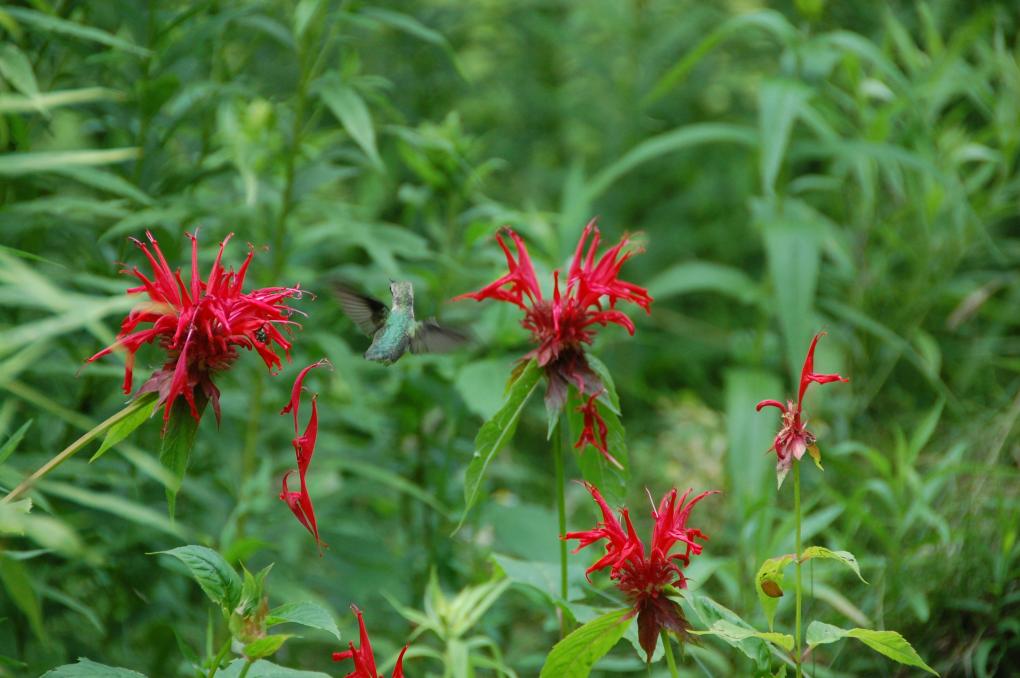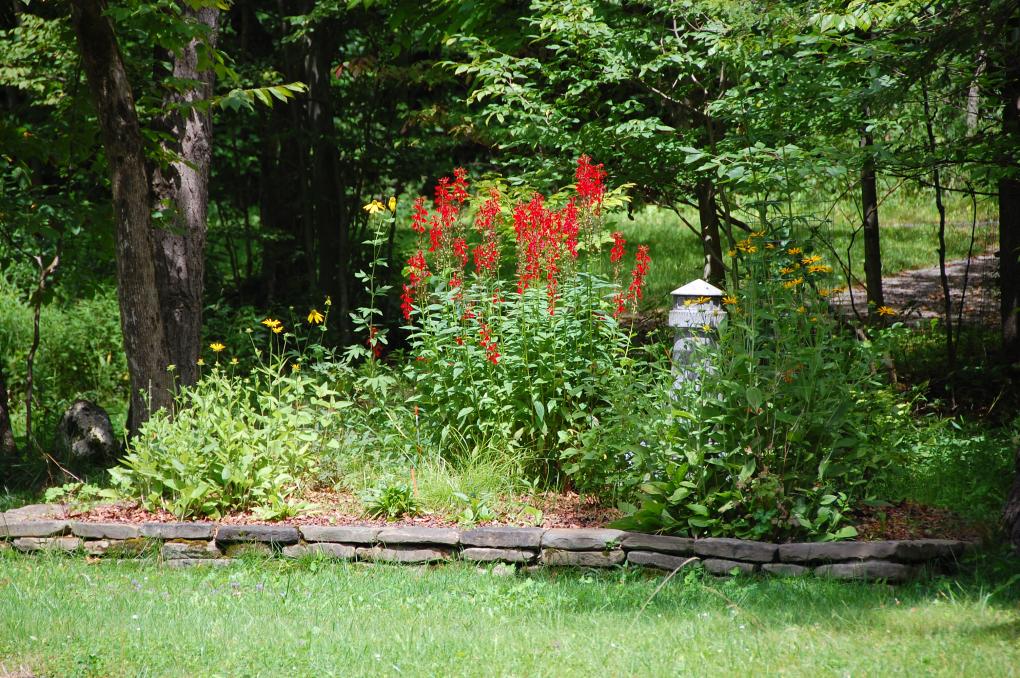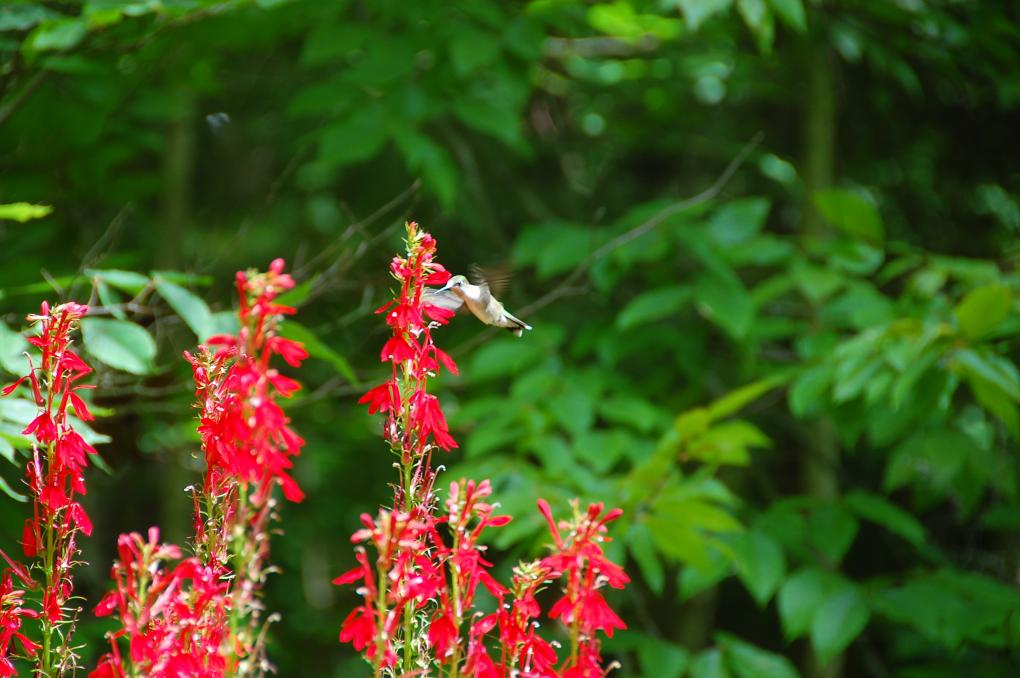The Cornell Lab Bird Academy › Discussion Groups › The Wonderful World of Hummingbirds › What Makes a Hummingbird a Hummingbird
-
we sometimes see them here in the front range in Colorado but more often in the mountains. I do put out a feeder and plant flowering plants; but I have been told to be careful of preditors which can make it dangerous for them. Last year I didn't see one at my feeder. I am not sure if it was the feeder or food I prepared following good directions and keeping it safe for them to feed on. I have the feeder in an open area as suggested. Two years ago, I was able to photograph one or two at the feeder. The most common here in our area. I used the Cornell app to identify it.
-
Here in Santa Barbara CA we see Anna's and Allen's, or Rufous/Allen hummingbirds every day at our feeders. I'm looking at a few right now!
-
Yes! I live in Western Oregon and we get Rufous and Anna's hummingbirds here. I see Anna's everyday at my feeder and around my yard, Rufous I have only seen a few times during Spring migration.
-
 I live on Vancouver Island, British Columbia. I periodically see Rufous Hummingbirds during the spring and summer, though that has become increasingly uncommon. Sometimes I wonder if our very plentiful Anna's Hummingbirds are chasing them away. They are amazingly feisty about their territory, and I have witnessed some quite brutal fights between them. Anna's have been overwintering here on the Island for several decades. With our changing weather (increasingly cold and snowy winters), many people try to help them survive by feeding them. Here's one at my feeder this past week. In cold spells, like we are having now, I have to take the feeders in overnight - and, when its really cold, exchange the feeders many times during the day - so that the sugar-water doesn't freeze. Not even a heater is enough sometimes to prevent the sugar-water from freezing! Feeding them properly and keeping their feeders squeaky clean is a serious (but joyful) commitment. Most of the rest of the year, they rely on my many flowering garden plants - some of which I grow specifically for them.
I live on Vancouver Island, British Columbia. I periodically see Rufous Hummingbirds during the spring and summer, though that has become increasingly uncommon. Sometimes I wonder if our very plentiful Anna's Hummingbirds are chasing them away. They are amazingly feisty about their territory, and I have witnessed some quite brutal fights between them. Anna's have been overwintering here on the Island for several decades. With our changing weather (increasingly cold and snowy winters), many people try to help them survive by feeding them. Here's one at my feeder this past week. In cold spells, like we are having now, I have to take the feeders in overnight - and, when its really cold, exchange the feeders many times during the day - so that the sugar-water doesn't freeze. Not even a heater is enough sometimes to prevent the sugar-water from freezing! Feeding them properly and keeping their feeders squeaky clean is a serious (but joyful) commitment. Most of the rest of the year, they rely on my many flowering garden plants - some of which I grow specifically for them. -
The only hummingbirds I see in my area are Rufous Hummingbirds, but recently I travelled to see some beautiful Jamaican Mangos that were well worth the flight time!
-
I have seen Ruby-throated Hummingbirds numerous times either on a feeder or, more usually, our aloe vera plant flowers.
-
I think the only hummingbirds in my area are Ruby-Throated Hummingbirds. The first time I heard one, I thought I was being attacked by a really big bug! Here's an image I captured in 2019 off of my back porch. I was actually photographing a Tiger Swallow-Tail butterfly when this little female joined the scene. Totally unexpected but totally exciting!

-
Excellent! Lucky you to experience this and to capture the image. Congratulations.
-
@Yasmin Thank you! Happy New Year!
-
-
In my backyard I once had a surprise Calliope Hummingbird that was on a telephone wire. I have also had a couple Black Chinned Hummingbirds. Mostly I get Anna's Hummingbirds and Allen's Hummingbirds.
-
I have broad tailed hummingbirds who frequent my yard in the warm months of the year here in Colorado. I have also been fortunate to see black chinned hummingbirds as well as rufous hummingbirds come through my garden. I carved over 300 sq ft of Kentucky bluegrass out of my front yard and replaced it with a mix of native grasses, shrubs, and forbes, and that jump started the hummingbird annual attendance. I have counted as many as 6 in my front yard at one time, all feeding on various flowers within. It's a marvel and precisely the reason I planted as I did! I am enjoying this course so far!
-
You have obviously done and excellent job with 're-wilding' your front yard! Maybe some of your neighbours will follow your great example and make a greater habitat for these birds.
-
@Yasmin I moved to Sedona over a year ago and started developing a areas of my yard fit for hummingbirds. They “buzz” me every morning as I bring out the feeders every morning in the winter’s first light of the day. A few male Anna’s will immediacy perch and feed while my hands are still on the feeder. I’ve seen 4 male Anna’s at one time aggressively vying for first feeding from the feeder. I also recently have received certification that my yard is a “Hummingbird Haven” from the International Hummingbird Society! My neighbors are supportive of this and are inquiring! Find joy in the small things and prosper!
-
-
I wanted to add to my posting of 12/1/24. This course is fabulous. I'm enjoying Kevin's engaging presentation style. The photos and videos are spectacular. Most of all, I am learning so much. I've been inspired to search the internet for more information. I just researched the Olivaceous thorn bill as I could hardly believe that this bird is a hummingbird. It is indeed. So interesting to see it hop around on the ground for low growing flowers! I look forward to every lesson and will be so sad when this course ends. I'm planning to sign up for the world of woodpeckers next! Thanks Cornell for offering such a wide variety of courses. Life Long Learner, Donna
-
I just finished the woodpeckers course, Donna. I think that all these courses at Bird Academy are fabulous. Bird Biology is incredibly challenging and structured like a full time university course. I highly recommend it but plan on it taking a couple of years to complete.
-
@Yasmin Hello Yasmin, I was so surprised and pleased to receive notice of your replies to my ruby-throated hummingbird postings. First of all, I'm So glad you have been introduced to the two native flowers species, Bee Balm and Northern Cardinal flower. Northern Cardinal Flower, native to Canada, has been beloved by my husband and me for decades. It is also Native to New York, but for us it is a north country wildflower as that is where we have only seen it, on many canoe camping trips in Ontario and Quebec. I just had to have this flower growing around our woodland ponds for us to enjoy and for our ruby throats to feast on. It's deep red color in late summer is a real eye-catcher. Wanting to spread this beautiful native pollinator in our area, I have given away plant starts and seeds. Thanks for the recommendation of the woodpecker course. I was planning to sign up for this one, but decided at the last minute, to enroll in Spring Field Ornithology North East. It will help me ID more birds in our region. That said, I will be sure to enroll in the woodpecker course next time, especially after reading your positive review of it. I see that you have taken 6 course already. Good for you! Your fellow birder, Donna
-
@Yasmin PS I wanted to mention, my husband and I have driven through the beautiful city of Ottawa several times on our way to La Vérendrye wildlife reserve. Of course, we enjoyed stopping to eat lunch or dinner at a restaurant before continuing north. Happy New Year! Donna
-
-
I have offered sugar nectar for the ruby-throated humming birds for decades, here in Western New York. Once I found a nest in a low hanging hemlock branch and was able to watch the two nestling develop. That was many years ago and I was not photographing nature as much then. Still, I will never forget that experience. A few years ago, a friend told me she had a rufous visiting her feeder tube in the fall. This is a rare sighting for Western New York, so I went over to have a look. The humming bird was much more sensitive to close watching than our beloved ruby throats. I few years ago, I planted bee balm and Northern Cardinal flowers. Both are favorite fueling up places for our ruby. This summer, I jut happened to have my camera handy to take these photos. I was thrilled, of course, to capture these images, a first for me!



-
Thank you for sharing these photos. I am in Ottawa, Canada and I will follow your lead with some of your plantings.
-
-
Yes, I get to see Allen's and Rufous hummingbirds. We set up a bird bath out of a pet drinking fountain, and during the summer the hummingbirds use it all the time!


-
That pet drinking fountain turned into a hummingbird bath is such a great idea. Thanks for sharing that!
-
What a great idea! Thank you for sharing.
-
-
I have Ruby-Throated Hummingbirds that nest in the woods near me and come to my feeders in the summer. Ruby-throats are the only hummingbird common in Michigan, but I have seen a few other species while visiting Arizona. I would love to be able to travel to see more of the variety that you are sharing in this course. It was fascinating to learn how the iridescence works.
-
What do they feed their babies/young?
-
In Ontario we have the Ruby throated hummingbird. I have been lucky to see many hummingbird species both in southern Arizona and Costa Rica. This course is inspiring me to go and see more hummingbirds.


-
So beautiful! Thanks for sharing. I'd love the chance to see those!
-
-
I used to see hummingbirds all the time growing up in Arizona. My grandma hung feeders and also grew some trumpet flowers that they really loved. I unfortunately have no idea which species they may have been. We get about six species here in Nebraska, though they zoom by so quickly, I can barely spot them, much less get my camera ready. Hoping once spring hits I can camp them out a bit and get some photos!
-
 We (my husband and I) have been lucky enough to see Ruby-throated Hummingbirds both in our backyard (we have 2 feeders during the spring/summer/fall, and in the woods in CT. The Ruby-throated Hummingbird (female) pictured here was seen in a CT State Park (Aug 10, 2024), where she stayed resting for a very long time and allowed many pictures. I think we left before she did.
We (my husband and I) have been lucky enough to see Ruby-throated Hummingbirds both in our backyard (we have 2 feeders during the spring/summer/fall, and in the woods in CT. The Ruby-throated Hummingbird (female) pictured here was seen in a CT State Park (Aug 10, 2024), where she stayed resting for a very long time and allowed many pictures. I think we left before she did. -

 When we moved to our new house, that first summer was the first time I saw a hummingbird “in the wild” (as in not on a documentary!). It was feeding from these red flowers called African Flag (chasmanthe floribunda) in the front yard. So, I decided to out up some hummingbird feeders the next year, but they didn’t stop at the feeders much, no matter how often I cleaned them and topped them up. My husband found out about this organization, Gardening for Wildlife, and they recommended local plants that hummingbirds love, especially our local Ruby-throated ones! We have cardinal flowers, rose of Sharon, wild bergamot, columbine, and they even come to the lilac trees in the spring! So now we make sure to plant and propagate those and keep a fountain running in the summer to help our hummer friends!
When we moved to our new house, that first summer was the first time I saw a hummingbird “in the wild” (as in not on a documentary!). It was feeding from these red flowers called African Flag (chasmanthe floribunda) in the front yard. So, I decided to out up some hummingbird feeders the next year, but they didn’t stop at the feeders much, no matter how often I cleaned them and topped them up. My husband found out about this organization, Gardening for Wildlife, and they recommended local plants that hummingbirds love, especially our local Ruby-throated ones! We have cardinal flowers, rose of Sharon, wild bergamot, columbine, and they even come to the lilac trees in the spring! So now we make sure to plant and propagate those and keep a fountain running in the summer to help our hummer friends! -
Thank you for the ideas of some more plants to add to my yard. :) We get ruby-throated hummingbirds, and they love the wild bergamot in the garden here too. I have also seen them getting nectar from zinnias, butterfly bush, and bleeding hearts.
-
-
Yes! We get mainly Black-chinned Hummingbirds where we live in the Western US, but we get some Rufous and Calliope during the summer. I also love seeing the Anna's during the winter too! I had the chance to go to Costa Rica, where I saw a lot of hummingbirds and a larger representation from the different groups discussed in the lesson. My favorite was the Green-breasted Mango - she looked huge at first compared to the hummers I'm used to seeing! I didn't get a picture of her, but below the Anna's are a couple others, I believe the Stripe-tailed Hummer and Lesser Violetear (who were very loud!).



-
Awesome photos! Thanks for sharing and the inspiration!
-
-

 I have feeders on my balcony. Only one type of hummingbird visits but some seem smaller so youngsters I think.
I have feeders on my balcony. Only one type of hummingbird visits but some seem smaller so youngsters I think. -
Wow! On your balcony! Wow, wow, wow! Thanks for the inspiration.
-
-
Yes we have a hummingbird feeder at home where we see Anna’s hummingbirds. I often see them in the neighborhoods of Seattle. My strongest memory of a hummingbird is the one I saw hovering outside the 14th floor window of a high-rise office building! There were no plants or balcony, so I am not sure why it was outside the window.
-
I have seen three species of hummingbirds in my life. The Rufous and Ruby-throated hummingbirds were features or talked about but you have not talked about the Black-chinned hummingbird yet. I live in NJ so the Ruby-throat I see quite often in the summer at my feeders. However, the Rufous is considered a rare bird for the State and I have seen it on twice in different years. I also bird in LA often and this year I took a detour to Texas to see the Golden Cheek warbler and as a bonus I saw the Black Chinned hummingbird. My wife and I really enjoy hummingbirds, and we are headed out to Arizona May 2025 where I hope to pick up 9 new species if all goes well. This is one of the main reasons I am taking this class. I will be brushing up on my Western Warblers with your other course. Just love learning about birds. Thanks and keep the courses coming.
-
There are at least 3 Ruby throated hummingbirds that visit my backyard everyday. This female is feeding off my Red Cardinal Flower plant. There is also a hummingbird feeder they like to feed from. When I take it down to change the water, there is always one hovering around the feeder station looking for it. I think they are all females. One of them chased a Black Capped Chickadee away for a couple days in a row, very aggressively . The hummingbird chased it from the feeder and through the trees. Also, I watched them twirling around each other and flying here and there for quite sometime. It was pretty amazing. They also hovered above my head for a while. They do chase each other away from the feeder and plant. That’s about it. I live in Massachusetts.

-
We have a summer home in Winter Park, CO (elevation 9,000 ft) so we get to see lots of summer nesters and migrating hummingbirds. We have four species that visit our feeders in Winter Park: Rufous, Calliope, Black-chinned and Broad-tailed. Here are two pictures of an adult male Rufous hummingbird and a picture of an adult male Calliope. (In order from top to bottom: Rufous, Calliope, Rufous).



-
In 2009 my wife and I were lucky enough to have a holiday in Ecuador. We managed to get a picture of a Rufous-tailed Hummingbird on the nest.


 Of course there were many other pictures.
Of course there were many other pictures.
 I live on Vancouver Island, British Columbia. I periodically see Rufous Hummingbirds during the spring and summer, though that has become increasingly uncommon. Sometimes I wonder if our very plentiful Anna's Hummingbirds are chasing them away. They are amazingly feisty about their territory, and I have witnessed some quite brutal fights between them. Anna's have been overwintering here on the Island for several decades. With our changing weather (increasingly cold and snowy winters), many people try to help them survive by feeding them. Here's one at my feeder this past week. In cold spells, like we are having now, I have to take the feeders in overnight - and, when its really cold, exchange the feeders many times during the day - so that the sugar-water doesn't freeze. Not even a heater is enough sometimes to prevent the sugar-water from freezing! Feeding them properly and keeping their feeders squeaky clean is a serious (but joyful) commitment. Most of the rest of the year, they rely on my many flowering garden plants - some of which I grow specifically for them.
I live on Vancouver Island, British Columbia. I periodically see Rufous Hummingbirds during the spring and summer, though that has become increasingly uncommon. Sometimes I wonder if our very plentiful Anna's Hummingbirds are chasing them away. They are amazingly feisty about their territory, and I have witnessed some quite brutal fights between them. Anna's have been overwintering here on the Island for several decades. With our changing weather (increasingly cold and snowy winters), many people try to help them survive by feeding them. Here's one at my feeder this past week. In cold spells, like we are having now, I have to take the feeders in overnight - and, when its really cold, exchange the feeders many times during the day - so that the sugar-water doesn't freeze. Not even a heater is enough sometimes to prevent the sugar-water from freezing! Feeding them properly and keeping their feeders squeaky clean is a serious (but joyful) commitment. Most of the rest of the year, they rely on my many flowering garden plants - some of which I grow specifically for them. 







 We (my husband and I) have been lucky enough to see Ruby-throated Hummingbirds both in our backyard (we have 2 feeders during the spring/summer/fall, and in the woods in CT. The Ruby-throated Hummingbird (female) pictured here was seen in a CT State Park (Aug 10, 2024), where she stayed resting for a very long time and allowed many pictures. I think we left before she did.
We (my husband and I) have been lucky enough to see Ruby-throated Hummingbirds both in our backyard (we have 2 feeders during the spring/summer/fall, and in the woods in CT. The Ruby-throated Hummingbird (female) pictured here was seen in a CT State Park (Aug 10, 2024), where she stayed resting for a very long time and allowed many pictures. I think we left before she did. 
 When we moved to our new house, that first summer was the first time I saw a hummingbird “in the wild” (as in not on a documentary!). It was feeding from these red flowers called African Flag (chasmanthe floribunda) in the front yard. So, I decided to out up some hummingbird feeders the next year, but they didn’t stop at the feeders much, no matter how often I cleaned them and topped them up. My husband found out about this organization, Gardening for Wildlife, and they recommended local plants that hummingbirds love, especially our local Ruby-throated ones! We have cardinal flowers, rose of Sharon, wild bergamot, columbine, and they even come to the lilac trees in the spring! So now we make sure to plant and propagate those and keep a fountain running in the summer to help our hummer friends!
When we moved to our new house, that first summer was the first time I saw a hummingbird “in the wild” (as in not on a documentary!). It was feeding from these red flowers called African Flag (chasmanthe floribunda) in the front yard. So, I decided to out up some hummingbird feeders the next year, but they didn’t stop at the feeders much, no matter how often I cleaned them and topped them up. My husband found out about this organization, Gardening for Wildlife, and they recommended local plants that hummingbirds love, especially our local Ruby-throated ones! We have cardinal flowers, rose of Sharon, wild bergamot, columbine, and they even come to the lilac trees in the spring! So now we make sure to plant and propagate those and keep a fountain running in the summer to help our hummer friends! 



 I have feeders on my balcony. Only one type of hummingbird visits but some seem smaller so youngsters I think.
I have feeders on my balcony. Only one type of hummingbird visits but some seem smaller so youngsters I think. 





 Of course there were many other pictures.
Of course there were many other pictures.